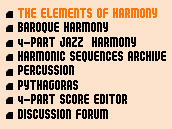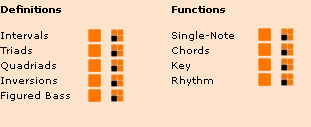


The Elements of Harmony > Key (in-depth)


Modulation
To describe the modulation from one key to another, we can adopt the following notation:
An L-shaped bracket indicates a modulation. Chords before the bracket belong to the
preceding key, while chords after the bracket belong to the new "target" key. Furthermore,
the target key is indicated to the right of the bracket, like this: .
In modulating from one key to the next, certain harmonic formulae must be invoked in
order to create a smooth transition. The following table, showing most modulations in
symbolic form, describes the harmonic procedures for modulating from a current to a
target key. Chords are notated using Chord Type nomenclature, which is the simplest
to understand and visualize. See footnotes for further explanations.
Modulation Procedures using Chord Type nomenclature
Current Key |
Target Key |
Procedure |
| I | VIm | I - ∟VIm V7 - i Note: It's best to use a commom chord before V7 |
| I | IV | I - ∟IV V7 - I |
| I | IVm | I - ∟ IVm V7 - i |
| I | V | I - ∟V V7 - I Note: It's best to use a commom chord before V7 |
| I | IIm | I - ∟IIm V7 - i |
| I | IIIm | I - ∟IIIm V7 - i Note: It's best to use a commom chord before V7 |
| I | II | I - V (common chord) - ∟II V7 - I |
| I | I - IV (common chord) - ∟bVII V7 - I or I - ∟bVII - iiø24** - V56 - I |
|
| I | VIIm | I - iii (common chord) - ∟VIIm V7 - i |
| I | Vm | I - i (mode change) - ∟Vm V7 - i |
| Im | i - ∟bIII V7 - I | |
| Im | IV | i - I (mode change) - ∟IV V7 - I |
| Im | IIm | i - V (common chord*) - ∟IIm V7 - i |
| Im | i - ∟bVIIm iiø24 - V56 - i | |
| Im | i - iv (common chord) - ∟bII V7 - I | |
| I | I - viiº56** - ∟bIII viiº7** - I | |
| I | VI | I - ∟VIm V7 - i - ∟VI V7 - I |
| I | Im | I - iiø7** - V∟I i |
| Im | I | i - iiø7** - V ∟I - I |
| I | III | I - I - I b7 ∟III iiø3#4#6*** - I46 - V7 - I |
| I | I - ∟IVm - V7 - I - ∟bVI V56 - I | |
| I | VII | I - V - ∟VII iiø3#4#6*** - I46 - V7 - I |
| I | I - ∟IVm V(V7) - VI - ∟bII II - V- I or I - ∟bV V24 - I6 - ∟bII V7 - I |
|
| I | #Im |
I - ∟IVm V(V7) - VI - ∟bIIm iiº - V- i or I - ∟#IVm V24 - I6 - ∟#Im V7 - i |
| I | #IV or |
I - ∟#IV V24 - I6 - ii7 (or ii56 or IV) - I46 - V7 - I |
| I | I - ∟bV V24 - I6 ∟bIIIm V7 - i | |
| I | #IVm | I - ∟#IVm V24 - i6 - iiø7 (or iiø56 or iv) - i46 - V7 - i |
| I | I - V -∟VII iiø3#4#6*** - I46 - V7 - I ∟bVIm V7 - i | |
| I | I - ∟bVIIm iiø24** - V56 - i |
* consider melodic minor scale of Target Key.
**consider harmonic major or harmonic minor scale of Current Key.
*** consider harmonic major scale of Target Key
How to interpret the nomenclature:
-
In the "Current" and "Target" columns, roman numerals denote the location on the major scale of the Tonic of each key, and the letter denotes whether the key is major or minor.
- In the "Procedure" column, all roman numerals (shown in blue) represent triads in
root position, and therefore indicate the function of the entire chord.
- Uppercase roman numerals denote a triad with a major 3rd, while lowercase roman numerals denote a triad with a minor 3rd.
- The remaining part of the chord symbol determines the presence or not of a 7th,
possible alteration of the 5th and possible inversion of the chord. The exact
meaning of the symbols ø and º are described here, while the interpretation of
the arabic numerals is described here.
The Elements of Harmony | Baroque Harmony | 4-Part Jazz Harmony | Harmonic Sequences Archive | Percussion | Pythagoras | 4-Part Score Editor | Discussion Forum